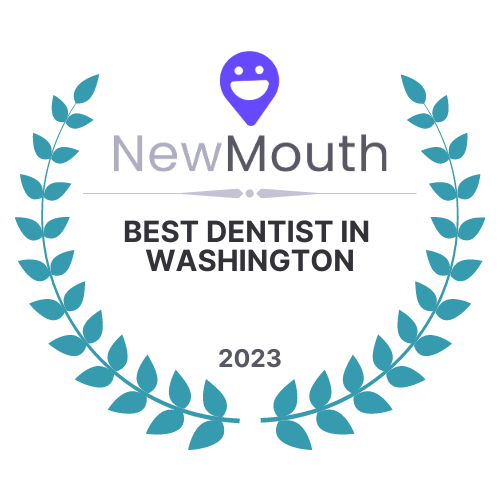New Patients & Dental Emergencies Welcome • We Speak English, Spanish, and Persian • 4444 Connecticut Ave NW, Washington DC, DC 20008 • (202) 363-2810
New Paragraph
Can You Drive After Taking Nitrous Oxide/Laughing Gas?
Can You Drive After Taking Nitrous Oxide/Laughing Gas?
Did you know laughing gas, or nitrous oxide, is used in over 85% of dental offices in the United States? It makes patients feel calm and relaxed. Most can drive safely right after their visit. This makes nitrous oxide a top choice for dental sedation, blending comfort with convenience.
Nitrous oxide helps ease dental anxiety and discomfort. It keeps patients calm and awake during treatments. Knowing how it works and its effects after use is key for safe benefits.
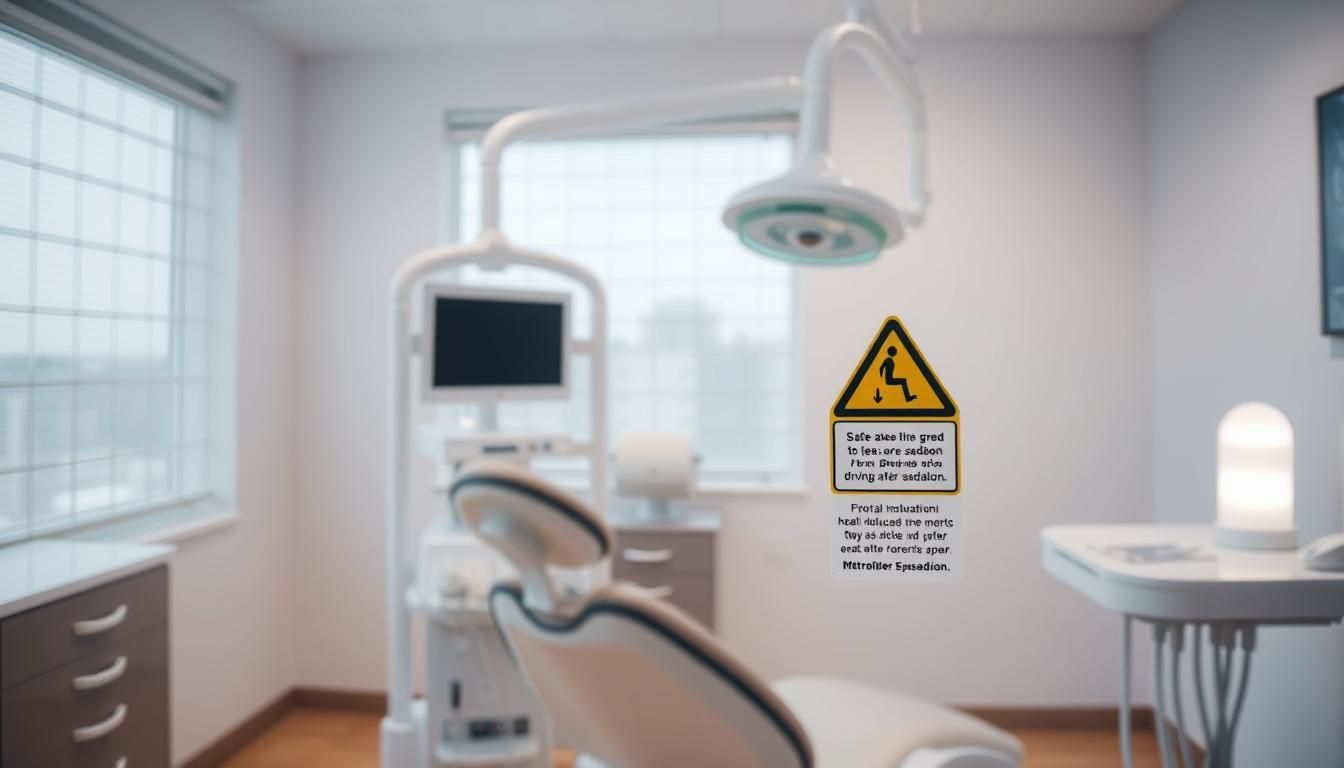
Key Takeaways
- Nitrous oxide, or laughing gas, is metabolized quickly, allowing a fast return to normal mental state.
- Most patients feel calm and conscious during dental procedures when administered laughing gas.
- Side effects like nausea or headaches from nitrous oxide are generally mild and short-lived.
- Laughing gas does not impair the ability to drive, making it suitable for post-treatment driving.
- This sedation method is beneficial for patients with dental anxiety or restlessness.
Introduction to Nitrous Oxide and Its Uses
Nitrous oxide, also known as "laughing gas," has changed dental sedation. It's safe and effective, making it a key medicine worldwide. First used in 1844, it helps patients relax during dental work.
In dentistry, nitrous oxide is given through a mask. This mixes the gas with oxygen for safe sedation. The idea started with Joseph Thomas Clover's gas-ether inhaler in 1876.
Nitrous oxide is not just for teeth. It's used in food, tech, and even car racing. It's colorless, stable at room temperature, and helps engines run better.
But, nitrous oxide also harms the environment. It's a greenhouse gas, adding to global warming. In 2020, it was 333 parts per billion in the air, growing by 1 part per billion each year.
Doctors have used nitrous oxide for over 200 years. Thomas Beddoes and James Watt first tried it for lung diseases in 1794. It works fast because it's mostly breathed out.
Nitrous oxide is used in many ways. It's mixed with oxygen to make treatments safer. This makes it vital in many fields.
How Nitrous Oxide Works in Dentistry
Nitrous oxide, also known as laughing gas, has been used in dentistry for over 170 years. It was first used in 1844 by Horace Wells. This sedative helps reduce pain and anxiety, making dental visits more comfortable.
The gas is given through a soft nosepiece. Let's explore how it's given and its immediate effects.
Administration Process
The process starts with a mask over the nose. The gas is mixed with oxygen for safe delivery. It takes about twenty seconds for the gas to reach the brain.
In two to three minutes, it starts to block pain receptors. Dental professionals control the gas flow to match each patient's needs. Local anesthetics are often used with nitrous oxide for painless procedures like fillings and extractions.
Immediate Effects
The effects of nitrous oxide are immediate and beneficial. Patients feel light-headed, experience tingling, warmth, and euphoria. Some might feel like they're floating or vibrating.
This sedative effect is similar to having a few glasses of wine. It keeps patients calm and relaxed. After the procedure, the gas is turned off, and 100% oxygen is given to flush out the gas.
This allows patients to quickly return to normal, usually in five to ten minutes. It's safe for them to drive home afterward.
Common Side Effects of Nitrous Oxide
Nitrous oxide, also known as laughing gas, is safe for medical and dental use. It's important to know the possible side effects to ensure safety. We will look at common symptoms that can happen during and after use.
Temporary Symptoms
When using nitrous oxide, people might feel a few temporary symptoms. These include:
- Dizziness
- Fatigue
- Light-headedness
- Excessive sweating
- Feeling of nausea
Some might also feel:
- Shivering
- Vomiting
- Sound distortion
- Hallucinations
These symptoms usually don't last long. They often go away once the gas stops being used. Proper use and safety measures, like giving oxygen after, can help lessen these effects.
Post-Procedure Symptoms
After the procedure, some people might feel mild side effects. These can include:
- Headaches
- Nausea
- Mild confusion
- Lingering dizziness
Medical News Today says headaches and nausea usually go away quickly. Rarely, allergic reactions can happen, showing as fever, chills, or hives. If side effects last, it's best to talk to a healthcare provider.
Knowing about nitrous oxide side effects helps keep patients safe during dental or medical procedures. It makes the experience better for everyone.
Duration of Nitrous Oxide Effects
Nitrous oxide's effects are short-lived, making it perfect for medical procedures. When the gas is switched to pure oxygen, its effects fade in minutes. This quick recovery lets patients get back to normal almost right away, cutting down on downtime.
Knowing how long nitrous oxide lasts is key for doctors and patients. Its short-lived effects mean a fast return to normal life. For dental visits, this means patients can get back to their day quickly after their appointment.
The fast recovery is a big plus of using nitrous oxide. Unlike some sedatives, it doesn't leave people feeling groggy for hours. Talking openly about how long nitrous oxide lasts helps patients feel less anxious and improves their treatment experience.
Also, nitrous oxide is safe and efficient because it's used carefully. This ensures the sedation is just right and not too long, which is best for patient care.
Can You Drive After Taking Nitrous Oxide?
It's important to know if it's safe to drive after using nitrous oxide, also known as laughing gas, at the dentist. The nitrous oxide effects usually go away quickly, in about 5-10 minutes after stopping the gas. But, it's best to wait a bit longer before driving to make sure the sedative is fully out of your system.
Dentists often suggest that a trusted adult drive you home after your visit. This is to prevent any side effects like dizziness, drowsiness, or nausea. If you can't find someone to drive you, taking a taxi or using a rideshare service is a good idea.
It's key to be safe when using nitrous oxide. Tell your dentist about any health issues, medicines, or substances you've used before your visit. This helps prevent bad reactions and figure out how long you should wait before driving.
Even though most people feel okay to drive soon after, everyone reacts differently. Some might be ready to drive right away, while others might need 15 to 30 minutes. To be safe, stay at the dental office until you feel completely back to normal.
For most, driving after laughing gas is okay once the immediate effects have gone away. But, it's always better to be careful. If you're not sure you're ready to drive, it's safer to have someone else do it.
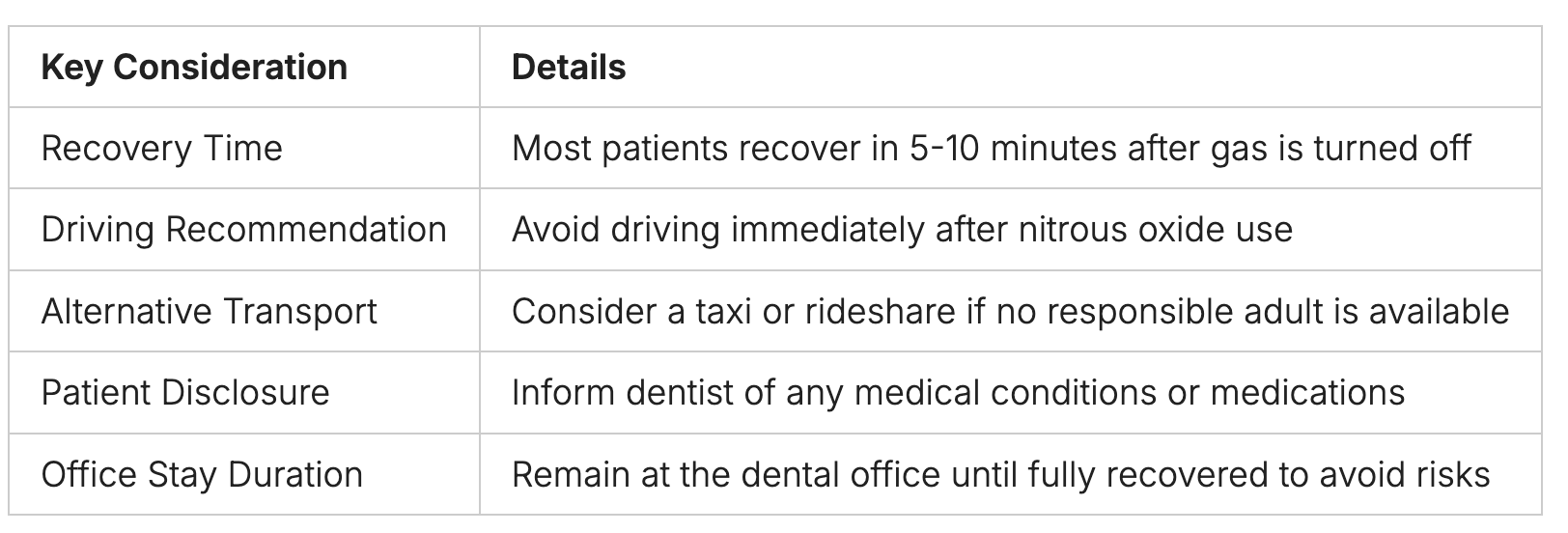
Safety Measures and Precautions
Nitrous oxide, also known as "laughing gas," is used in dental procedures. It's important to follow strict safety rules to keep patients safe. Places like DC Implant & Cosmetic Dentistry have strict rules to make sure nitrous oxide is safe.
Monitoring During the Procedure
When nitrous oxide is given, many safety steps are taken. The gas mix is set to keep the patient safe. This mix makes sure the patient gets enough oxygen.
A serene scene depicting a car parked safely on the side of a quiet road, surrounded by lush greenery, with a small warning sign about nitrous oxide usage nearby. The vehicle's door is gently open, and an empty canister of nitrous oxide rests on the ground, emphasizing caution. Soft sunlight filters through the trees, creating a calm atmosphere while highlighting the importance of safety and awareness.
- The oxygen fail-safe system turns off nitrous oxide if oxygen levels drop. This ensures a safe oxygen flow rate.
- An oxygen flush button gives 100% oxygen quickly in emergencies.
- The pin-index safety system stops the wrong tanks from being used.
- Quick connects for oxygen are ready for CPR or other urgent needs.
- The reservoir bag keeps the oxygen flow steady during breathing.
Ensuring Full Recovery
After treatment, patients are watched until they're fully awake. This is to make sure they're safe to go back to their daily life. It's important to wait until the sedation has worn off.
There are strict rules for exposure limits and safety:
- NIOSH says workers should not breathe in more than 25 ppm of Nitrous Oxide over 10 hours. ACGIH suggests 50 ppm over 8 hours.
- Employers check for dangerous substances and train workers under OSHA rules.
- There are ways to lower exposure, like ventilation and protective gear.
By following these strict rules, places make sure nitrous oxide is safe. This lowers the chance of bad outcomes for patients and workers.
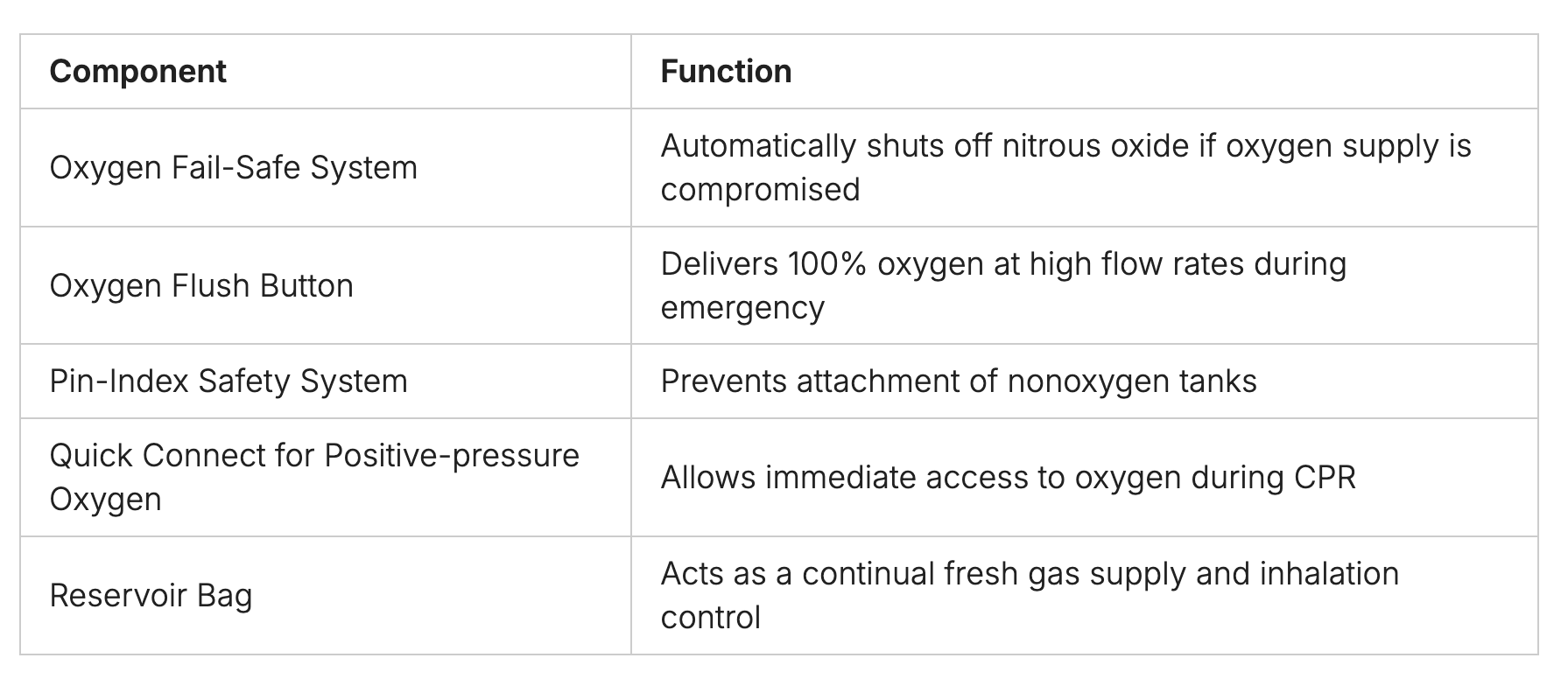
Applications Beyond Major Dental Procedures
Nitrous oxide is not just for big dental surgeries. It's also great for routine cleanings and small procedures. This is a big help for people who get really nervous or have special needs.
Patients breathe in nitrous oxide through a nose mask. They stay awake but don't feel pain. It works by releasing natural opioids, making people feel happy and warm fast.
Doctors use nitrous oxide applications for small surgeries, even on kids. Parents can stay with their kids, making them feel safer. Safety checks, like knowing the right dose for a child's weight, are always done.
Doctors watch the patient's heart rate, oxygen, and breathing closely. This way, they can act fast if something goes wrong. Nitrous oxide wears off quickly, so kids can get back to their day fast.
But, nitrous oxide does have an environmental downside because it's a strong greenhouse gas. Yet, there are plans to make it safer for our planet while keeping it useful in medicine.
Nitrous oxide is the top choice for dental sedation, used by about 70% of dentists. It's a trusted way to keep patients comfortable and pain-free, no matter the procedure size.
Comparison With Other Sedation Methods
When looking at dental sedation options, it's key to know the differences. This includes onset, duration, cost, and recovery time. Nitrous oxide, or laughing gas, is a mild sedation often used in dentistry, like at 200 W Chatham St., Apex.
Mild vs. Deep Sedation
Let's compare sedation methods like nitrous oxide to oral conscious sedation and IV sedation. Each has its own benefits and drawbacks:
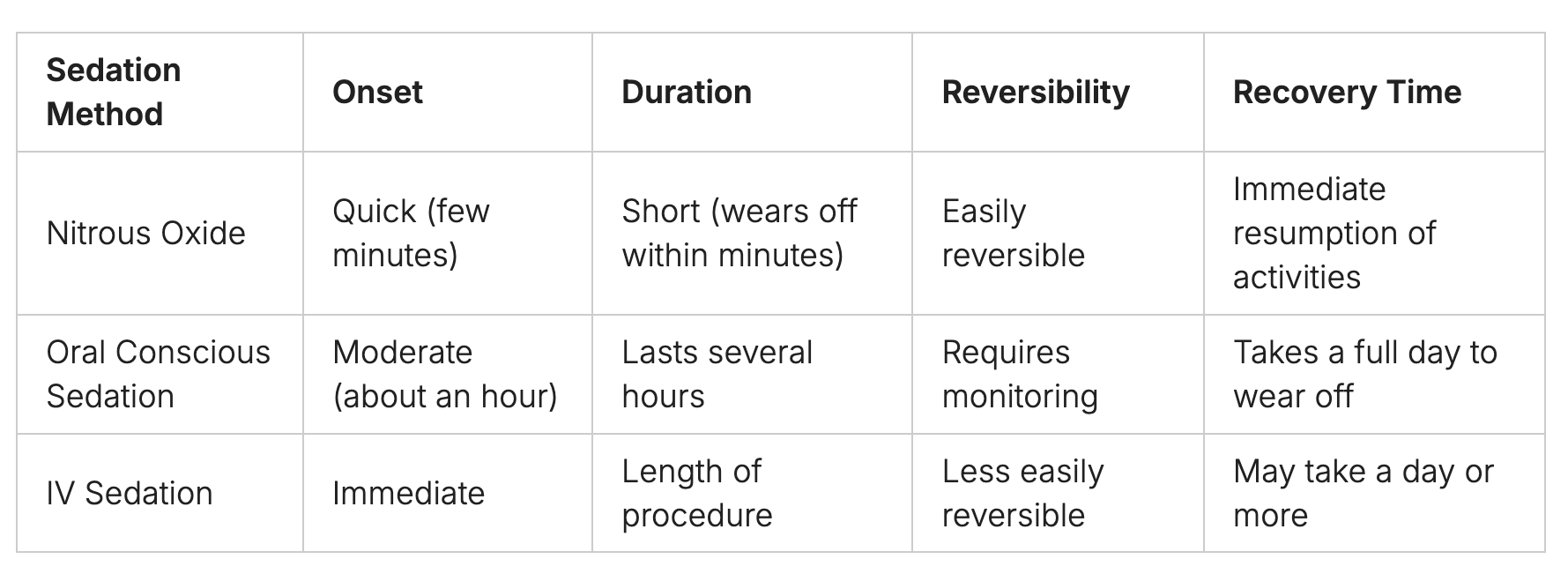
Effects on Motor Skills
The impact of dental sedation on motor skills differs by type. Nitrous oxide keeps patients aware and in control, unlike deeper sedation:
- Nitrous Oxide: Keeps motor skills intact, allowing safe driving home without drowsiness.
- Oral Conscious Sedation: Impairs motor skills, needing help for transport after the procedure.
- IV Sedation: Greatly impairs motor skills; requires professional help for safe recovery and transport.
The right sedation choice depends on personal needs and preferences. Nitrous oxide stands out for its gentle yet effective nature. It has a quick onset, few side effects, and little impact on motor skills. This makes it ideal for quickly getting back to normal after a dental visit.
Conclusion
Nitrous oxide, also known as laughing gas, is a common sedative in dentistry. It is safe and allows for quick recovery. The article discussed its safety and the few side effects it has when used right.
Patients thinking about using nitrous oxide should talk to experts. Places like DC Implant & Cosmetic Dentistry offer safe and personalized care.
During the COVID-19 lockdown, there have been reports of neurological problems linked to nitrous oxide abuse. A study found five patients with serious neurological issues after misuse. Long-term use can lead to serious health problems, showing the need for careful monitoring.
It's important to talk about the growing problem of nitrous oxide misuse among teens and young adults. Data shows a big increase in misuse cases, leading to serious health issues. In 2020, poison control centers saw 134 misuse cases, up from 46 the year before.
Managing misuse involves stopping use and taking vitamin B12 to help recover. This approach helps reduce risks.
Nitrous oxide is beneficial in dental settings but needs careful use to avoid harm. Raising awareness and teaching about its safe use is key. This review highlights its dental benefits and the need for responsible use to prevent health problems.



